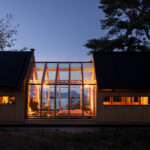The future of online education is wide open, and in the world of architecture, Frank Gehry is seeking to bring everyone one step closer to that future. The recent announcement of his course on architecture and design for MasterClass, available this spring, is the latest foray the profession has taken into online education, but this one brings an existential crisis along with it.
While other online architecture classes have been taught by such institutions as Harvard and TU Delft, Gehry’s course, which is similar in structure to those offerings, is paired alongside other celebrity-centered classes that teach crafts like acting, singing and writing — pursuits that someone can practice professionally without accredited degrees or licensure. And despite limits of scope imposed by its short duration, Gehry’s course, and other online architecture courses, aren’t drastically different from the format of most professional architecture programs. This begs the question: What does it mean to become an architect?
The first thing to keep in mind is that no one would seriously take Gehry’s course with the aim of becoming an architect. Besides its lack of legal standing with licensing authorities, it’s clear this class is intended for an audience of hobbyists.
While it might seem like a cruel joke to architecture students that someone would decide to model and draw imaginary buildings in their spare time, for fun, the standing of this video-based class as a commercial product for a target demographic is perfectly clear in its preview. Set to an orchestral soundtrack that crescendos between Gehry’s musings on his practice, the trailer fits squarely into the man’s brand; it could just as easily be an advertisement for the similarly styled 2005 documentary “Sketches of Frank Gehry.”

Via World Architecture Community
However, despite its obvious intent as entertainment, the class is also selling the idea that the practice of architecture can be accomplished as an artistic distraction on evenings and weekends. While most practicing architects would laugh at this notion, customers of Gehry’s MasterClass will nonetheless sketch parti diagrams, draw floor plans and craft conceptual study models just like real architecture students. So what’s the difference between a real architecture education and a fake one?
Time commitment is a clear difference, as Gehry’s 15 video lessons couldn’t possibly stack up to a typical five-year architecture degree, but the primary distinction seems to be the level of feedback offered. Gehry’s class attempts to acknowledge this by allowing students to upload images of their work and critique each other, and Gehry himself will even offer remarks on select uploads, but this practice is mere lip service relative to the amount of feedback degree-seeking architecture students receive.

Most architecture programs immerse students in a high-frequency cycle of production and critique, and while I posit that this system realizes diminishing returns past a certain point, it’s undeniable that hearing more than a few people’s reactions to your creative work will improve it. So if Gehry’s class is a prompt for considering what’s required to become an architect, it seems the answer might be undergoing an acceptable amount of battering at the hands of other architects.
In the absence of this critical framework, Gehry’s class takes a much different approach: It attempts to teach the process of design in an objective, lesson-based manner. In the preview, Gehry is quoted as saying: “When you build a building — any building — start with a simple block model to see where that goes.” In a later frame, the title card for Lesson No. 3 states: “Frank believes that finding your creative signature is key to developing exciting, engaging and completely differentiated designs. In this chapter, you will learn what a creative signature is and how you can start to recognize your own.”

A still from Frank Gehry’s MasterClass trailer; via MasterClass
This type of instruction is a double-edged sword. On one hand, it’s a fallacy because Gehry’s method of designing buildings is simply his personal interpretation of the practice; anyone who employs his methods will never achieve the same results. That’s likely why this sort of step-by-step teaching of design is almost entirely absent from formal architecture education because, in theory, it only serves to replicate an instructor’s tendencies.
However, examining the details of someone’s working process can be helpful for a novice who has no idea where to start, or refreshing for a more advanced student who is tired of their own methods and wants to expand their frame of reference. The way Gehry approaches this in his online class seems to illustrate a weak spot in the real-world academic system, which is almost completely devoid of this sort of discourse.
To that end, a defining feature of Gehry’s class, and other online architecture courses, is that they appear to be focused on teaching just as much as they are on doing — a definite shift from today’s formal architecture education. Could this be the future of architecture school if it were to follow our society’s seemingly inevitable progression onto the internet? Perhaps, but in the meantime, “real” architecture schools might benefit from paying attention to what’s happening in the virtual ones.
Via World Architecture Community









